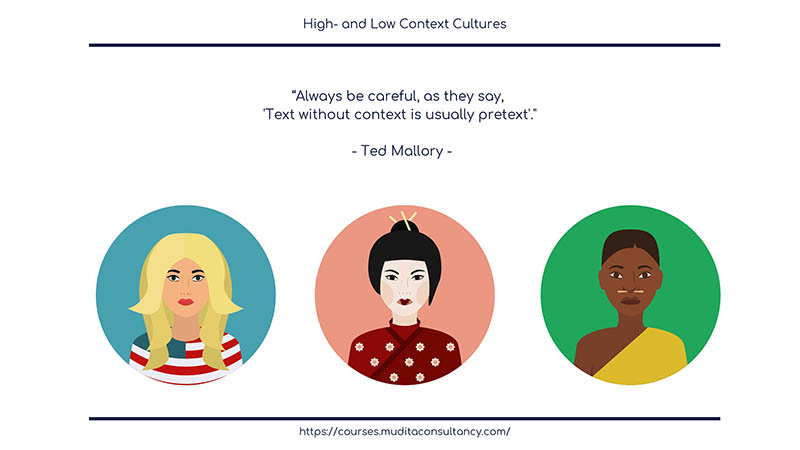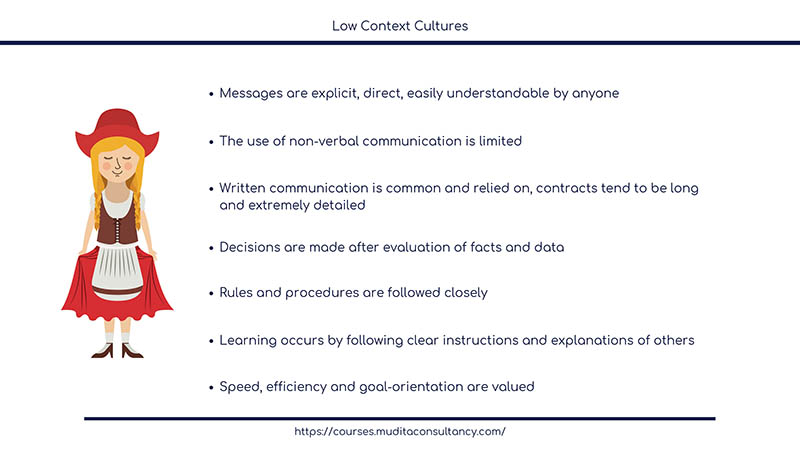Communication: High- and Low-Context Cultures
Always be careful, as they say, 'Text without context is usually pretext
- Ted Mallory -
In 1976, anthropologist E.T. Hall developed the iceberg analogy of culture: he theorized that if culture was an iceberg, some of its aspects (above the water line) would be visible and obvious to everyone, while most of them (the unconscious aspects) would be hidden below the water line and only accessible to outsiders after a certain amount of time spent observing and learning about the new culture.
Perhaps unsurprisingly, our audience can only be fully understood once we gain insight into their "inner functioning": is our interlocutor a member of a high- or a low-context culture? And what are the main differences between the two (note: according to Hall's research, approximately 70% of the world cultures are estimated to be high-context, with high- context indicating a situation where most knowledge happens below the water line)?
Let's find out.
In high-context cultures (that include - but are not limited to - most Latin-American, Southern European, Asian and African countries, tribal communities around the world):
- Messages are implicit, indirect and require a certain degree of interpretation to be understood (understanding of what is said is "internalized", knowledge is both relational and situational). Context is more valuable than words;
- The use of non-verbal communication (voice, gestures, etc.) is significant;
- Reliance on written communication is low: knowledge of " unwritten " rules tends to be assumed;
- High-context societies are defined by strong boundaries and "in-group mentality", differentiating between who belongs and "outsiders;
- Relationships develop over time, tend to last long, and are the element around which decisions are made;
- Rules and procedures are somewhat flexible (as per previous point, relationships are the priority);
- Identity and status may be disclosed "non-verbally" and require proper acknowledgement;
- Learning occurs by observing first and then replicating the process;
- Accuracy and thoroughness are valued.
In low-context cultures (that include - but are not limited to - Scandinavian countries, most English- and German speaking countries):
- Messages are explicit, direct, easily understandable by both insiders and outsiders;
- The use of non-verbal communication is limited;
- Written communication is common and relied on, contracts tend to be long and extremely detailed;
- Sources of knowledge are usually external, public, ideally accessible at any time by anyone. Knowledge is easily transferable;
- Business relationships are mainly of practical nature, they are forged fast and they don't last long;
- Decisions are made after evaluation of facts and data and they revolve around needs and responsibilities;
- Rules and procedures are followed closely;
- Learning occurs by following clear instructions and explanations of others;
- Speed, efficiency and goal-orientation are valued;
- Strong compartmentalization tendencies: relationships, tasks, activities, do not mix. There is a time and a place for everything.
Note: no culture is entirely low- or high-context. For example, in North America (low-context) people may resort to high-context communication when dealing with family members or close friends, while the Japanese (high-context) are likely switch to low-context communication when dealing with foreigners.
Examples of low- and high-context cultures are those based in the following culture clusters:
High-context cultures
The Sub-Saharan Africa Cluster
Low-context cultures
It is also important to note that:
- low-context cultures are usually monochronic (monochronic time is linear, based on "man made", clock-based, time measurement criteria) and individualistic;
- high-context cultures tend to be polychronic (polychronic time is cyclical, based on a repetition of natural cycles and patterns) and collectivist.
***
Mudita’s Course on Intercultural Communication is available here:
https://courses.muditaconsultancy.com/courses/An-Introduction-to-Intercultural-Communication
SOURCES
Disclosure: all the below are affiliate links, and if you go through them to make a purchase I will earn a commission (at no additional cost to you).
Hall’s Cultural Dimensions (High- vs low-context cultures, polychronic- vs monochronic cultures)
- Hall E.T. (1959). “The Silent Language”. New York: Doubleday
- Hall, E.T. (1966). “The Hidden Dimension”. New York, NY: Doubleday
- Hall, E. T. (1976). "Beyond culture". New York, NY: Doubleday
- Hall Edward T. (1983). “The dance of life : the other dimension of time”. New York, NY: Doubleday
Hofstede’s Cultural Dimensions (Individualistic vs collectivist cultures)
- Hofstede, G. H. (1997). “Cultures and Organizations: Software of the Mind” (second ed.). New York: McGraw-Hill
Culture Clusters
- House, R. J., Hanges, P. J., Javidan, M., Dorfman, P. W., & Gupta, V. (2004). "Culture, leadership, and organizations: The GLOBE study of 62 societies". CA: Thousand Oaks







